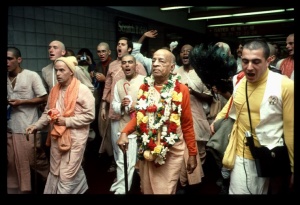SB 7.5.17: Difference between revisions
m (1 revision(s)) |
No edit summary |
||
| Line 1: | Line 1: | ||
{{info | {{info | ||
|speaker= | |speaker=Ṣaṇḍa and Amarka | ||
|listener= | |listener=Prahlāda Mahārāja | ||
}} | }} | ||
[[Category:Srimad-Bhagavatam - Canto 07 Chapter 05]] | |||
[[Category:Bhagavatam Verses Spoken by Sanda and Amarka - Vanisource|070517]] | |||
<div style="float:left">'''[[Srimad-Bhagavatam]] - [[SB 7|Seventh Canto]] - [[SB 7.5: Prahlada Maharaja, the Saintly Son of Hiranyakasipu|Chapter 5: Prahlāda Mahārāja, the Saintly Son of Hiraṇyakaśipu]]'''</div> | |||
<div style="float:right">[[File:Go-previous.png|link=SB 7.5.16]] '''[[SB 7.5.16]] - [[SB 7.5.18]]''' [[File:Go-next.png|link=SB 7.5.18]]</div> | |||
{{RandomImage}} | |||
==== TEXT 17 ==== | ==== TEXT 17 ==== | ||
<div | <div class="verse"> | ||
daiteya-candana-vane | :daiteya-candana-vane | ||
jāto 'yaṁ kaṇṭaka-drumaḥ | :jāto 'yaṁ kaṇṭaka-drumaḥ | ||
yan-mūlonmūla-paraśor | :yan-mūlonmūla-paraśor | ||
viṣṇor nālāyito 'rbhakaḥ | :viṣṇor nālāyito 'rbhakaḥ | ||
</div> | </div> | ||
| Line 17: | Line 22: | ||
==== SYNONYMS ==== | ==== SYNONYMS ==== | ||
<div | <div class="synonyms"> | ||
''daiteya''—of the demoniac family; ''candana-vane''—in the sandalwood forest; ''jātaḥ''—born; ''ayam''—this; ''kaṇṭaka-drumaḥ''—thorn tree; ''yat''—of which; ''mūla''—of the roots; ''unmūla''—in the cutting; ''paraśoḥ''—who is like an axe; ''viṣṇoḥ''—of Lord Viṣṇu; ''nālāyitaḥ''—the handle; ''arbhakaḥ''—boy. | |||
</div> | </div> | ||
| Line 24: | Line 29: | ||
==== TRANSLATION ==== | ==== TRANSLATION ==== | ||
<div | <div class="translation"> | ||
This rascal Prahlāda has appeared like a thorn tree in a forest of sandalwood. To cut down sandalwood trees, an axe is needed, and the wood of the thorn tree is very suitable for the handle of such an axe. Lord Viṣṇu is the axe for cutting down the sandalwood forest of the family of demons, and this Prahlāda is the handle for that axe. | This rascal Prahlāda has appeared like a thorn tree in a forest of sandalwood. To cut down sandalwood trees, an axe is needed, and the wood of the thorn tree is very suitable for the handle of such an axe. Lord Viṣṇu is the axe for cutting down the sandalwood forest of the family of demons, and this Prahlāda is the handle for that axe. | ||
</div> | </div> | ||
| Line 31: | Line 36: | ||
==== PURPORT ==== | ==== PURPORT ==== | ||
<div | <div class="purport"> | ||
Thorn trees generally grow in deserted places, not in sandalwood forests, but the seminal brāhmaṇas Ṣaṇḍa and Amarka compared the dynasty of the Daitya Hiraṇyakaśipu to a sandalwood forest and compared Prahlāda Mahārāja to a hard, strong thorn tree that could provide the handle of an axe. They compared Lord Viṣṇu to the axe itself. An axe alone cannot cut a thorn tree; it needs a handle, which may be made of the wood of a thorn tree. Thus the thorn tree of demoniac civilization can be cut to pieces by the axe of viṣṇu-bhakti, devotional service to Lord Kṛṣṇa. Some of the members of the demoniac civilization, like Prahlāda Mahārāja, may become the handle for the axe, to assist Lord Viṣṇu, and thus the entire forest of demoniac civilization can be cut to pieces. | Thorn trees generally grow in deserted places, not in sandalwood forests, but the seminal ''brāhmaṇas'' Ṣaṇḍa and Amarka compared the dynasty of the Daitya Hiraṇyakaśipu to a sandalwood forest and compared Prahlāda Mahārāja to a hard, strong thorn tree that could provide the handle of an axe. They compared Lord Viṣṇu to the axe itself. An axe alone cannot cut a thorn tree; it needs a handle, which may be made of the wood of a thorn tree. Thus the thorn tree of demoniac civilization can be cut to pieces by the axe of ''viṣṇu-bhakti'', devotional service to Lord Kṛṣṇa. Some of the members of the demoniac civilization, like Prahlāda Mahārāja, may become the handle for the axe, to assist Lord Viṣṇu, and thus the entire forest of demoniac civilization can be cut to pieces. | ||
</div> | </div> | ||
__NOTOC__ | |||
<div style="float:right; clear:both;">[[File:Go-previous.png|link=SB 7.5.16]] '''[[SB 7.5.16]] - [[SB 7.5.18]]''' [[File:Go-next.png|link=SB 7.5.18]]</div> | |||
__NOTOC__ | |||
__NOEDITSECTION__ | |||
Revision as of 16:33, 31 May 2021

A.C. Bhaktivedanta Swami Prabhupada
TEXT 17
- daiteya-candana-vane
- jāto 'yaṁ kaṇṭaka-drumaḥ
- yan-mūlonmūla-paraśor
- viṣṇor nālāyito 'rbhakaḥ
SYNONYMS
daiteya—of the demoniac family; candana-vane—in the sandalwood forest; jātaḥ—born; ayam—this; kaṇṭaka-drumaḥ—thorn tree; yat—of which; mūla—of the roots; unmūla—in the cutting; paraśoḥ—who is like an axe; viṣṇoḥ—of Lord Viṣṇu; nālāyitaḥ—the handle; arbhakaḥ—boy.
TRANSLATION
This rascal Prahlāda has appeared like a thorn tree in a forest of sandalwood. To cut down sandalwood trees, an axe is needed, and the wood of the thorn tree is very suitable for the handle of such an axe. Lord Viṣṇu is the axe for cutting down the sandalwood forest of the family of demons, and this Prahlāda is the handle for that axe.
PURPORT
Thorn trees generally grow in deserted places, not in sandalwood forests, but the seminal brāhmaṇas Ṣaṇḍa and Amarka compared the dynasty of the Daitya Hiraṇyakaśipu to a sandalwood forest and compared Prahlāda Mahārāja to a hard, strong thorn tree that could provide the handle of an axe. They compared Lord Viṣṇu to the axe itself. An axe alone cannot cut a thorn tree; it needs a handle, which may be made of the wood of a thorn tree. Thus the thorn tree of demoniac civilization can be cut to pieces by the axe of viṣṇu-bhakti, devotional service to Lord Kṛṣṇa. Some of the members of the demoniac civilization, like Prahlāda Mahārāja, may become the handle for the axe, to assist Lord Viṣṇu, and thus the entire forest of demoniac civilization can be cut to pieces.